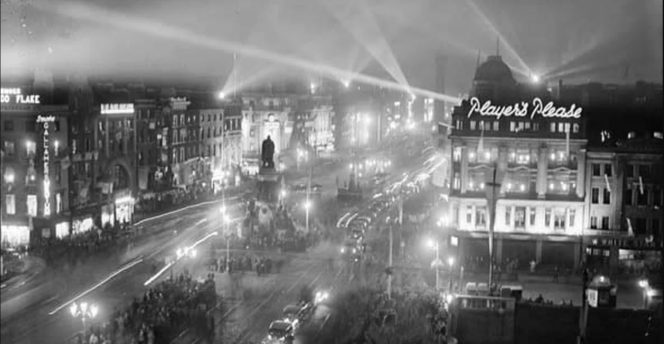How neon advertising signs lit up Dublin in the 1930s
ToggleBrightly-lit signs festooned the capital's streets in the 1930s and were very much a part of everyday life in the city, writes Dr Stephanie Rains, Department of Media Studies

But to the modern observer, one of the most striking things about the photograph is how illuminated the street already was by neon advertising signs attached to the rooflines and facades of many key buildings. These included a sign the width of an entire building facing onto O’Connell Bridge which announced 'Player’s Please’, while another exhorted smokers to buy Bendigo Flake tobacco. Underneath that, running vertically down the corner of the same building was a sign advertising Gallagher’s cigarettes.
1930s Ireland is not usually associated with extravagant consumer culture so the scale and brilliance of these signs may seem surprising. Yet not only was the street festooned with brightly-lit signs in 1932, but they were so much a part of everyday life that apparently no-one found them inappropriate or jarring during the staging of a religious event.

Neon was first discovered in 1898 and was soon being used along with other coloured gases in the distinctive tubes, often referred to in earlier decades simply as ‘electric signs’. Capable of being curved to make an infinite variety of shapes and sequenced on and off to give the illusion of movement, it was hardly surprising that the rapidly-developing modern advertising industry of the era saw neon’s possibilities.
The first neon advertisement in Dublin was probably the large Bovril sign which glowed green, white and red on the upper stories of a building overlooking College Green from before World War One. Their numbers increased in the Free State era. When a new sign for Mex motor oils was erected on the front of a building on Upper O’Connell Street in February 1932 (which therefore would have been in place for the Eucharistic Congress in June of that year) it was warmly greeted by the Irish Press.
A short piece commented that ‘there has been a considerable increase in the number of firms and traders using electric signs in Dublin’. The following year saw the establishment of Gaelite Signs, Ireland’s first manufacturer of neon signage (a company still in business today), who promoted themselves with the slogan ‘After Daylight Comes Gaelite’.
Of course, not all commentators appreciated the profusion of neon signs. The Dublin City Architect, in a talk he gave to advertising executives in 1928, could well have been thinking of the buildings on the corners of O’Connell Street and O’Connell Bridge when he complained, ‘the modern craze of publicity had taken a heavy toll of architecture. Buildings, in the estimation of the advertiser, would seem to be merely backgrounds for signs and posters by day, and illuminated vulgarities by night’.
Just a few years later in 1937, WB Yeats appeared to feel that the very buildings of the restored and rebuilt O’Connell Street were part of that vulgarity. 'When I stand upon O'Connell Bridge in the half-light,' he mused, 'and notice that discordant architecture, all those electric signs, where modern heterogeneity has taken physical form, a vague hatred comes up out of my own dark’.
Such disapproval seems to have been quite rare however, and certainly did nothing to halt the brightly coloured signs. In August 1939, the old Bovril sign on College Green was replaced by a new version, which used a red and yellow flashing sunburst over the word ‘Bovril’. Noting this, the Irish Times diarist commented that, ‘the city is rapidly becoming a city of red and green neon signs. Even from the Dublin Mountains, on a clear night, red patches indicate the centre of the city and spread a tinge of scarlet among the clouds’.
However, the new Bovril sign erected in August 1939 would not have been long in operation before it and other advertising were switched off to conserve electricity for the duration of World War Two. This left the whole country distinctly under-lit, but the contrast between Dublin city centre’s previous red glow reflecting onto the clouds above the city with the cowled lampposts and unlit shops must have been particularly stark.
This was underlined by the excited tone of commentary when neon lights began to reappear after the end of the war. December 1945 saw the first lifting of lighting restrictions for shops, cinemas and advertising in the run up to Christmas. The Irish Independent explained that ‘most of the cinemas and some of the business houses have re-introduced flood lighting, and as soon as more Neon tubes are ready the familiar coloured signs will be flashing their welcome from every vantage point’.
O'Connell Street in the post-war years was the centre of the city’s nightlife, with cinemas, ballrooms, ice-cream parlours and coffee bars all using neon signs and decoration to attract customers. Cafolla's coffee bar for example had a very vibrant neon frontage.
This era would also see the arrival of the McDowell's Happy Ring House sign of ringing wedding bells, winking diamond ring and happy bridal couple, first attached to the jeweller’s facade in 1952. Along with the 1962 Why Go Bald? advertisement on Dame Lane off South Great George's Street, this would become one of the much-loved features of Dublin’s cityscape. In more recent years, both have been fully-restored to their previous animated glory.
But as the photograph from the 1932 Eucharistic Congress shows, O’Connell Street had by then been a ‘city of neon’ for many decades, adorned with the brand names, logos and dancing lights of Irish consumer culture.
This article originally appeared on RTÉ Brainstorm
